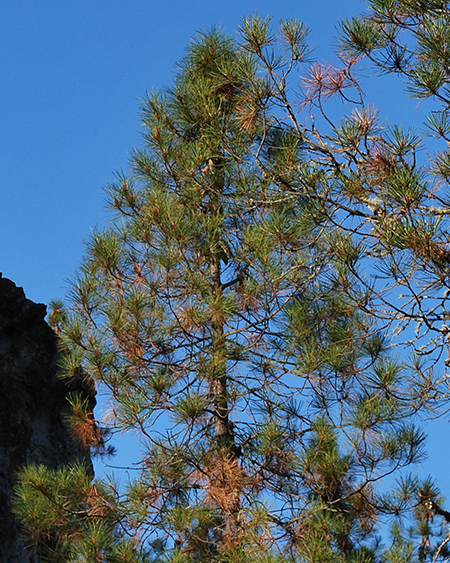
Pine trees (Pinus spp.) are the most common coniferous tree worldwide, numbering around 100 species. These trees form large forests characterized by wide open areas with sunlight spilling to the forest floor. Pines are sun-loving trees that do not grow well under shady conditions.
Most pines are susceptible to fire, and some species may contribute significantly to wildfires. Some speciaes are native, and should follow the recommendations related to maintinaing native fire-hazardous species.
Only the Bishop pine (pinus muricata) is a Marin native. The Bishop Pine has a very restricted range: mostly California, USA, including some offshore islands, and a few locations in Baja California, Mexico, and always on or near the coast, from Trinidad Head in Humboldt County, California south to San Vicente in Baja California. The mature trees grow to a height of 15-25 meter, rarely up to 34 meter, with a trunk diameter of up to 1.2 meter. The species is often smaller, stunted and twisted in coastal exposures. It is drought-tolerant and grows on dry, rocky soil. P. muricata has been used in plantations with resultant growth rates higher than in the wild, but with adverse impacts to biodiversity. The common name Bishop Pine resulted from the tree having been first identified near the Mission of San Luis Obispo. This tree has a large number of common names and other prior scientific names, due primarily to numerous variant forms. Other common pines are Knobcone Pine, Coulter Pine, Bishop Pine, Monterey Pine, Gray Pine, Pond Pine, Scots Pine, Torrey Pine.
Most species of pine trees are not recommended in the defensible space zone around structures or roadways. Consider removing pine trees within 100′ of structures or 15′ of roadways. If a pine tree must be maintained in the defensible space zone (within 100′ of structures), extreme care should be taken to reduce the associated wildfire hazard:
- Remove all limbs within 10′ of the ground, or 1/3 the height of the tree if less than 30′ tall
- Remove all dead wood and twiggy growth regularly
- Provide canopy separation so that no limbs touch nearby trees or plants
- Remove all “ladder fuels







